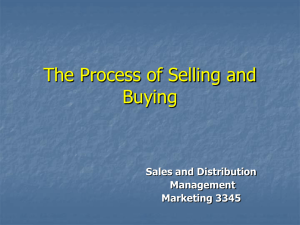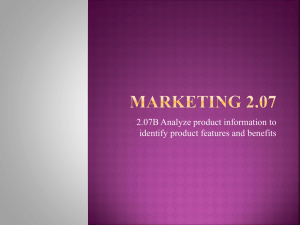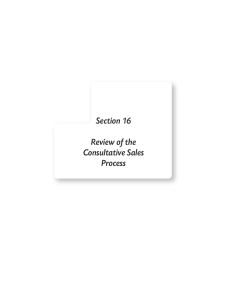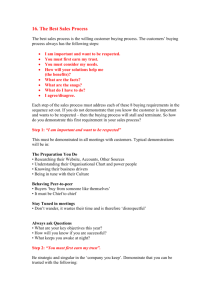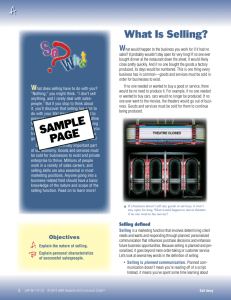The Buying Process and Buyer Behavior
advertisement
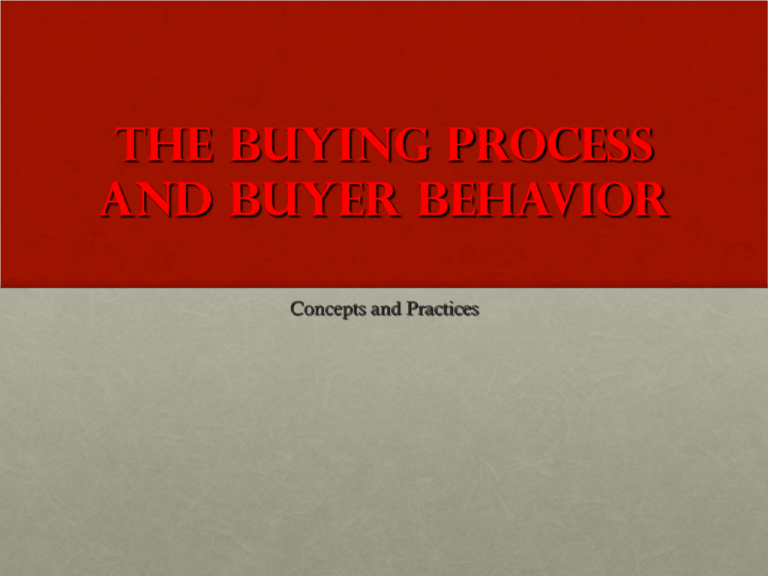
The Buying Process and Buyer Behavior Concepts and Practices Customer Strategy Defined “A customer strategy is a carefully conceived plan that results in maximum customer responsiveness. One major dimension of this strategy is to achieve a better understanding of the customer’s buying needs and motives.” 8-2 Strategic/Consultative Selling Model FIGURE 8-3 8.1 Complex Nature of Customer Behavior • Individual customers perceive the product in their own terms • The customer is a person, not a statistic • Companies that fully accept this basic truth are likely to adopt a one-to-one marketing strategy 8-4 Consumer versus Organizational Buyers • Consumer buyer behavior refers to the buying behavior of individuals and households who buy goods and services for personal consumption • Business (organizational) buyer behavior refers to the organizations that buy goods and services for use in the production of other products and services that are sold, rented, or supplied to others 8-5 Differences Between Consumer and Organizational Buyers FIGURE 8-6 8.2 Types of Organizational Buying Situations • New-task buy • Salespeople rely on consultative selling skills • Straight rebuy • Salespeople constantly monitor satisfaction • Modified rebuy • Salespeople can provide service/anticipate changes • Systems selling 8-7 Types of Consumer Buying Situations • Habitual buying situations • Variety-seeking buying situations • Complex buying situations 8-8 Achieving Alignment • The buying process is a systematic series of actions, or a series of defined, repeatable steps, intended to achieve a result • Salespeople need to be clear on how decisions are being made • Acquire specific information rather than make generalizations about the buyer’s decision-making process 8-9 Steps in the Buying Process FIGURE 8-10 8.3 Steps in the Buying Process • Need awareness • Salespeople can create value by determining problems and identifying solutions • Evaluation of solutions • Salespeople can create value by providing useful information • Resolution of problems 8-11 Steps in the Buying Process • Purchase • Salespeople create value by arranging financing or supervising delivery and installation • Implementation • Value creation involves timely delivery, superior installation, accurate invoicing, or follow-up contacts by the salesperson 8-12 Understanding Buying Processes • Transactional buyers • Salespeople can eliminate any unnecessary costs or delays • Consultative buyers • Salespeople focus attention on needs awareness/help customer evaluate solutions • Strategic alliance buyers 8-13 Buyer Resolution Theory • Why should I buy? (need) • What should I buy? (product) • Where should I buy? (source) • What is a fair price? (price) • When should I buy? (time) 8-14 Customer Strategy Model FIGURE 8-15 8.5 Basic Needs—Maslow FIGURE • Physiological: food, shelter • Security: free from danger • Social: identification with social groups, friendship • Esteem: desire to feel worthy in eyes of others • Self-actualization: need for mastery, self-fulfillment 8-16 8.6 Group Influences 8-17 FIGURE 8.7 Group Influences • Role: expectations associated with position • Reference groups: categories of people you see yourself belonging to • Social class: group with similar values, interests, lifestyles • Culture: influences of group with common language, environment, also subcultures 8-18 Discussion Question Overgeneralizing based on demographics can be dangerous. Remember, prospects act as individuals, not stereotypes. Some predict the demise of demographics in marketing. • How would this impact customer analysis? 8-19 Perception: Customer Need Formation • “Facts are negotiable. Perception is rock-solid.” • Selective attention: We tend to screen out certain messages . . . information overload • Buyers conditioned by social-cultural background and need to use various selective processes • Salespersons should encourage client to discuss “perceptions” of products 8-20 Buying Motives • A buying motive is an aroused need, drive, or desire that stimulates behavior to satisfy the aroused need • It’s helpful to discover the “dominant buying motive” or DBM • Four basic motive types—emotional, rational, patronage, and product 8-21 Emotional and Rational Motives Emotional Rational • Acts due to passion or sentiment • Acts on reason or judgment • Emotional appeals common • Relatively free of emotion • If two products are identical, the salesperson who “connects” has the advantage • Salespeople gather, interpret, and disseminate customerspecific information 8-22 Discussion Questions • What types of purchases would be dominated by emotional buying motives? • What types of purchases would be dominated by rational buying motives? 8-23 Customers Can Make Better Decisions Using: See the Website 8-24 Discussion Questions • What sort of role would information provided by sources like Consumer Reports play in a customer’s decision? • How can a salesperson use this information to his/her advantage? 8-25 Patronage and Product Motives Patronage • Buy from a particular firm Product • Past experience positive • Buyer believes one product is superior to others • Relevant elements: superior service, product selection, competent sales staff • Preferences for: specific brands, quality, price, design/engineering 8-26
